Looking For Professional Help in Identifying Japanese Knotweed?
Not sure if you have Japanese Knotweed on your property? Upload a photo of the suspected plant, and our team of experts will identify it for you for free within 24 hours. Simply provide your details, attach the photo, and hit send. It’s that easy!
Photo uploader
Most Comprehensive Guide to Identifying Japanese Knotweed
Japanese Knotweed can be challenging to identify if you’re not familiar with its appearance. This invasive plant goes through various growth stages, changing its look throughout the year. Use our guide to help you recognise Japanese Knotweed in each season and understand its unique features.
How to Identify Japanese Knotweed in Spring
In spring, Japanese Knotweed begins to emerge with red/purple asparagus-like shoots. These young shoots are bright red and sprout from the crown of the plant, growing rapidly. As they develop, the leaves start to unfurl, initially dark red and then turning green. The plant’s rapid growth in spring is a notable feature.
How to Identify Japanese Knotweed in Summer
By summer, Japanese Knotweed is in full growth mode. The plant’s stems are hollow and bamboo-like, often with distinctive purple speckles. The leaves are heart or shovel-shaped, arranged in a zigzag pattern along the stems. The plant can reach up to 3 meters in height during this season, dominating its surroundings.
How to Identify Japanese Knotweed in Autumn
In autumn, the leaves of Japanese Knotweed turn yellow and begin to fall off. The plant produces small, creamy white flowers that grow in loose clusters. The stems remain standing, giving a clear indication of the plant’s location. This seasonal change helps in identifying the plant even from a distance.
How to Identify Japanese Knotweed in Winter
During winter, Japanese Knotweed dies back, leaving brown, hollow stems that persist above ground. These dead canes are a key sign of the plant’s presence even when it’s not actively growing, making it easier to spot and identify. Winter reveals the plant’s skeletal structure, aiding in its identification.
Which Months Are Knotweed and Other Invasive Species Most Visible?
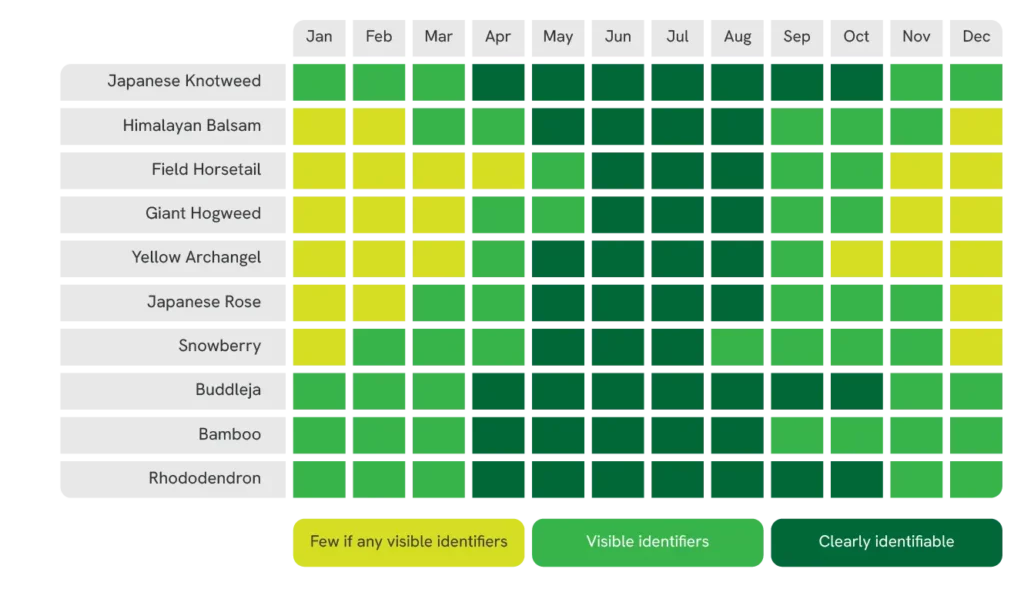
Identifying Japanese Knotweed Characteristics
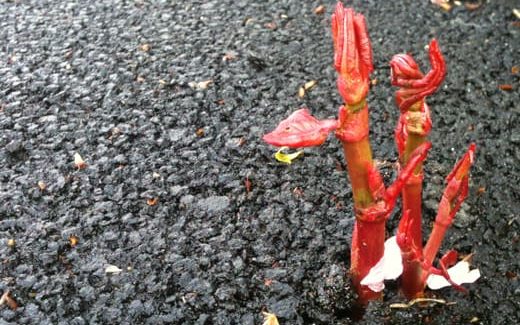
When looking for Japanese knotweed buds, look out for small red buds, which will sprout from the crown of the plant. The buds are bright and cherry-like, making them easy to spot. At this point, it can be tempting to try and remove the knotweed yourself, but should be avoided. While above ground growth is small, it is important to remember that a large network of Japanese knotweed roots already exists beneath the ground.

In early spring, Japanese knotweed shoots take the form of reddish-purple shoots sprouting from the ground. Left untreated, these will rapidly grow into the distinctive knotweed canes, but at this early point they are easily confused with the vegetable rhubarb. This is a mistake we have seen many surveyors make when examining properties, reinforcing the need for accurate professional knotweed examination. This is the ideal time to treat knotweed. The shoots are still small and the small size of your infestation means treatment options are flexible, which is why identifying Japanese knotweed early is vital.
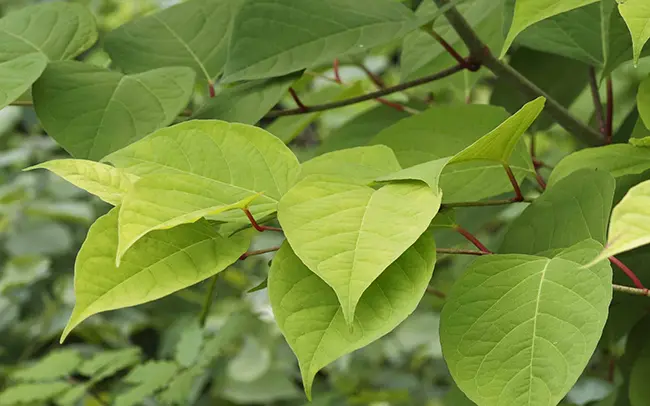
Japanese knotweed leaves are extremely distinctive. In summer the leaves grow and are spread in a zigzag shape on the stem, with the individual leaves being bright green in colour. The leaves grow in a heart-shape, having pointed tips and straight edges. Japanese knotweed leaves look different within the different seasons, being a light green, or red colour in spring. The leaves maintain their vivid green colour until autumn where they turn brown and eventually die.
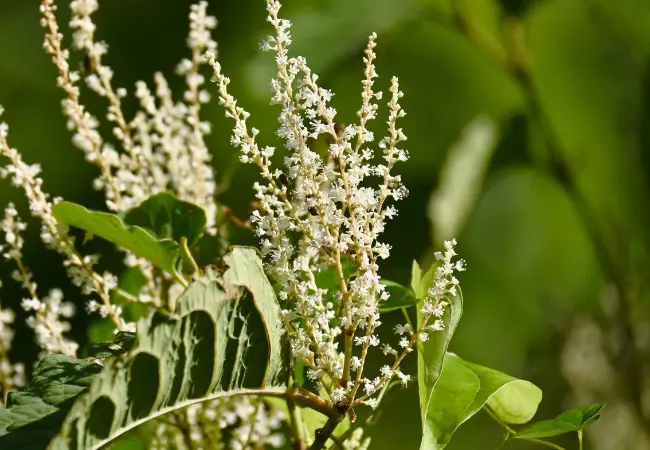
By the end of the summer, those small shoots can reach up to 3 metres in height, with root systems up to 3 metres deep and 7 metres across. By this stage, you should look out for Japanese knotweed flowers which appear as small creamy white flowers that cluster together on the vines. These flowers will remain on the plant until late autumn where they die as the stems die back.
How did Japanese Knotweed get to the UK?
Japanese knotweed (Fallopia japonica) is a native of Japan and was introduced during the Victorian period as an ornamental garden plant. Growing up to a metre a month, it quickly suffocates other vegetation and aggressively colonises any ground where it’s allowed to flourish.
The non-native weed spreads rapidly, with its bamboo-like stems and large bright green leaves growing up to 2m, with a complex rhizome network underground, making this a hard species to remove yourself. Simply pulling the plant up yourself will not stop it from spreading, but can cause it to spread even faster.

Japanese knotweed in the UK dates back to 1850 when a German-born botanist, Philipp Franz Balthasar von Siebold, brought it over to Victorian Britain.
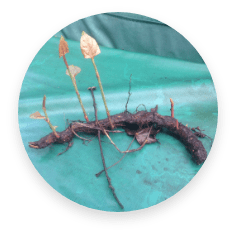
Over a period of many decades the plant was sold by a large number of nurseries and gardeners with cuttings being distributed into gardens nationwide.
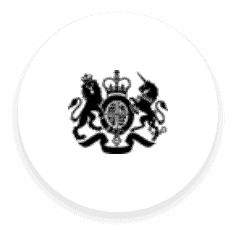
Japanese knotweed was added to the invasive species list and controlled under the Wildlife and Countryside Act 1981.
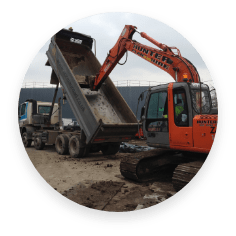
Legislation was updated to limit the spread and distribution of the species. This legislation requires transportation of Japanese knotweed to be completed by a registered waste carrier.




Japanese knotweed in the UK dates back to 1850 when a German-born botanist, Philipp Franz Balthasar von Siebold, brought it over to Victorian Britain.
Over a period of many decades the plant was sold by a large number of nurseries and gardeners with cuttings being distributed into gardens nationwide.
Japanese knotweed was added to the invasive species list and controlled under the Wildlife and Countryside Act 1981.
Legislation was updated to limit the spread and distribution of the species. This legislation requires transportation of Japanese knotweed to be completed by a registered waste carrier.
Why is Japanese knotweed a Problem?
View our new infographic for all you need to know about dealing with Japanese Knotweed.
How does Japanese Knotweed spread?
The problem with Japanese knotweed is that it can sprout from as little as 2mm of rhizome, meaning it is classed as “controlled waste” under the Environmental Protection Act of 1990 and must only be disposed of into licensed landfill sites to stop further spread. Any attempts to remove knotweed should therefore be carried out by licensed professionals. If any small portion of the plant is left in the soil, even a few inches, it can very quickly re-sprout. Only killing the entire underground root system will guarantee the removal of the plant.
Japanese Knotweed damage
Japanese knotweed damage can be extensive. knotweed’s strong, robust plant structure means it can thrive in a wide range of growing conditions. Soil pH or salinity has little impact on the growing rate of the plant, and it can survive temperatures as low as -35°C. This is how it is able to exploit gaps in concrete and brick, taking root and causing structural damage to driveways, roads, and property foundations.
This can seriously affect the value of your home and influence your chances of getting a mortgage accepted.
Its ability to grow up to 10cm a day during the summer means it can quickly and easily overwhelm competitor plants and threaten properties by taking root within foundations. Japanese knotweed root systems grow extensively, up to three metres deep and up to seven metres in all other directions. This makes removing the roots a difficult and labour-intensive task.
Why remove Japanese Knotweed?
Japanese Knotweed must be removed due to its potential for severe structural damage to buildings, gardens, and underground systems. Its powerful root system can penetrate weak points in foundations, walls, and patios, often leading to expensive repairs. Knotweed’s presence can decrease property values and complicate mortgage approvals, frequently requiring a professional removal plan.
Additionally, property owners are legally obligated to prevent its spread to avoid fines. Environmentally, Knotweed threatens biodiversity, crowding out native plants. Its removal is complex and costly, demanding professional intervention and regular maintenance. Acting quickly is essential to limit damage and financial strain.
Can I remove Japanese Knotweed myself?
Japanese Knotweed can regrow from cuttings as tiny as 2mm, making it highly resilient. Even the smallest fragments can spark new growth, which is why Knotweed is classified as controlled waste and must be disposed of at licensed landfill sites under the Environmental Protection Act (Duty of Care) Regulations 1991. For these reasons, removal is best left to licensed professionals.
The plant’s rhizome network, reaching up to 2m deep and 7m wide, remains alive beneath the ground and produces new shoots each spring. Knowing how to identify Knotweed in every season is crucial for avoiding delays in property sales or commercial projects. Our photo gallery above offers images of its various growth stages for easy identification.
Japanese Knotweed legislation
As an invasive species with the ability to cause such damage, there is strict legislation in place around the disposal and control of Japanese knotweed.
It is not a legal requirement to report Japanese knotweed, however if you are selling your home, it is a legal requirement to declare Japanese knotweed within the TA6 form and if it is, you also need to provide a Japanese knotweed removal plan in order to satisfy mortgage lender requirements.
One of the most common measures against Japanese knotweed is the Property Information Form, or TA6, a document used by sellers to give prospective buyers important information about the property so that they can make an informed decision.
Is it illegal to have Japanese Knotweed on my land?
It is not illegal to have Japanese knotweed growing on your land, however it is illegal to allow Japanese knotweed to spread to a neighbouring property or adjoining land.
Individuals with Japanese knotweed on their premises have a legal responsibility to prevent the spread of the weed into neighbouring locations. Failure to stop the spread of Japanese knotweed to neighbouring properties is an offence that can result in an Antisocial Behaviour Order (ASBO) and a fine of up to £2,500.
If there is Japanese knotweed in your neighbours garden or knotweed growth on adjoining land, you should speak directly with your neighbours or the landowners, as they could already be taking steps to prevent Japanese knotweed spread. In the event of the homeowner or landowner failing to act, you can contact you local council.
Looking for professional help in removing Japanese Knotweed?
Our expert team offers comprehensive Japanese Knotweed removal services. We use proven methods to ensure complete eradication, backed by our 10-year Insurance Backed Guarantee. Contact us today for a consultation and let us help you protect your property.
Want to know more About Japanese Knotweed?
Plants that look similar to Japanese Knotweed
Understanding the plants often mistaken for Japanese Knotweed helps avoid unnecessary worry. Learn how to distinguish Knotweed from its look-alikes:
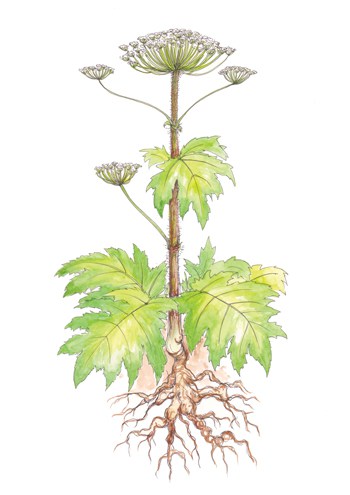
Giant Hogweed
Giant Hogweed is dangerous because its sap is harmful to humans through its ability to cause skin inflammations and burns when affected skin comes into contact with sunlight.
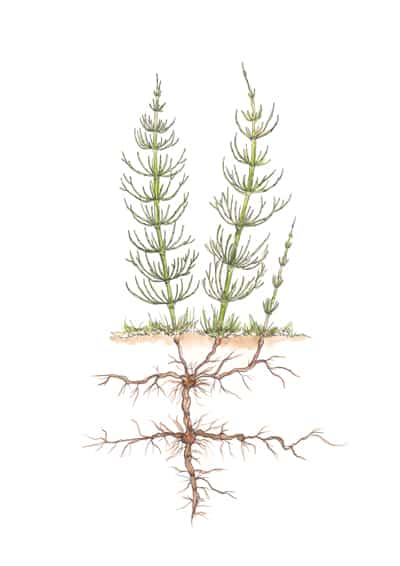
Horsetail
Horsetail is toxic, poisoning and potentially killing livestock that grazes on it, making horsetail removal a particular priority in the eyes of the farming and agriculture industries if found on land.
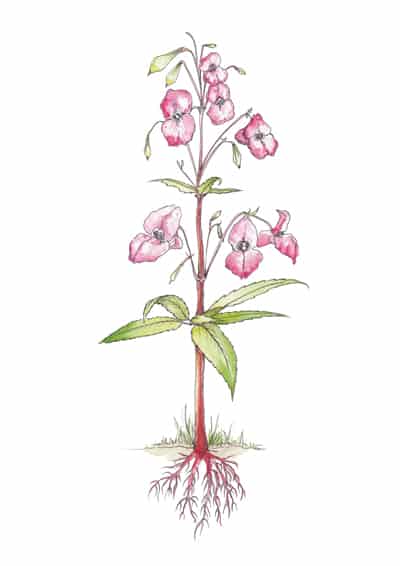
Himalayan Balsam
Himalayan Balsam can reach heights of over two metres, and is aggressively invasive. Due to legislation around spraying chemicals in the wild and near bodies of water, it is safest and most effective to hire professionals that can adhere to laws and best practice.
Getting rid of Japanese Knotweed The Right Way
If you believe your property has Japanese knotweed, it’s important to have a Japanese knotweed survey in order to find out the extent of the problem and the best course of treatment for your property and future use of the land.
There are various treatment and removal methods available including herbicides from foliar sprays to stem injections, as well as physically excavating the Japanese knotweed and disposing off-site.
Get in touch
Need more information or assistance? Contact us through our website or call our hotline. We’re here to help with all your Japanese Knotweed concerns.
Japanese Knotweed and Residential Property: Updated RICS Professional Standard
The Royal Institution of Chartered Surveyors (RICS) updated its guidance on Japanese Knotweed in October 2022, responding to findings from the House of Commons Science and Technology Committee and Defra investigations. This Professional Standard refines how the plant’s risks and impact on property values are assessed, emphasizing a more balanced, evidence-based approach. Key updates include a decision tree to help valuers determine the extent of an infestation and appropriate management, ensuring clear, objective assessments that build trust among lenders and stakeholders.
This updated guidance reflects the latest research and industry best practices, enabling RICS members to provide accurate advice for valuation and condition reports. By maintaining clarity and objectivity, the Professional Standard ensures confidence in the property market while addressing environmental and economic concerns. For more details, visit the RICS website.
